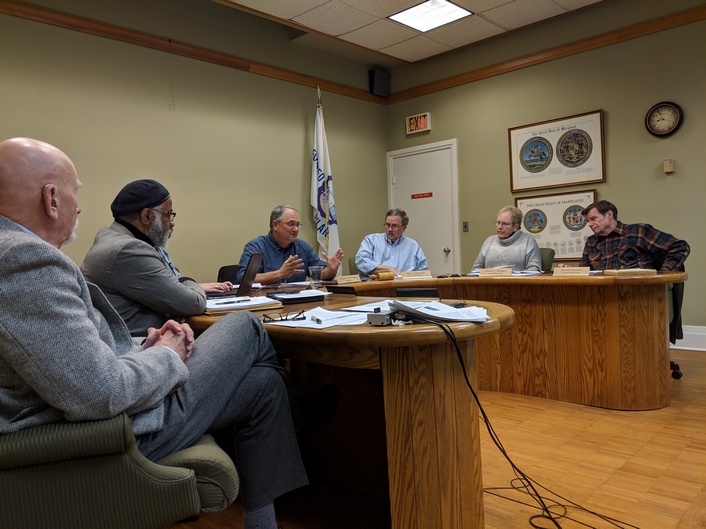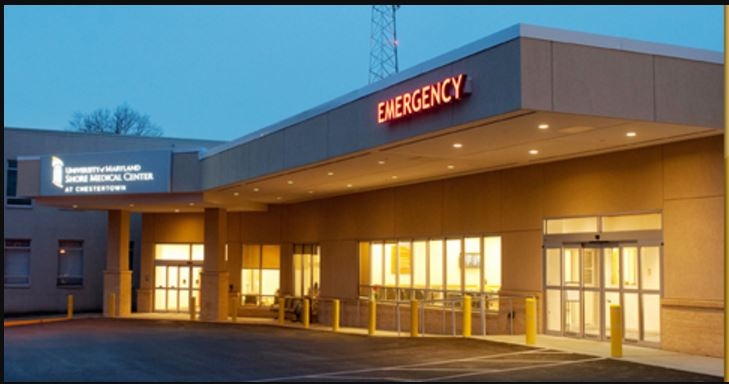
Mayor Chris Cerino (center) reports on a meeting with hospital officials proposing an end to an oil cleanup program. Also present (from left) are councilmen Marty Stetson and Ellsworth Tolliver, Town Manager Bill Ingersoll, and council members Linda Kuiper and David Foster.
Representatives of the Town of Chestertown met with CEO Ken Kozel and other officials of Shore Regional Health on Jan. 10 to discuss the status of the remediation of an oil spill on the grounds of the Chestertown hospital. Mayor Chris Cerino, Town Manager Bill Ingersoll, Utilities manager Bob Sipes, Councilman David Foster, and Michael Forlini, an environmental attorney working with the town, attended the meeting.
Cerino reported on the meeting at the Jan. 22 council meeting. He first summarized the history of the oil spill, which was first detected some 30 years ago under the hospital’s previous ownership. Some tens of thousands of gallons leaked from a heating fuel tank into the ground under the hospital. With the town’s wells and water works less than a mile downhill from the site of the spill, the cleanup has been a significant ongoing issue for both the town and the hospital.
The initial cleanup, begun in 1991, involved pumping water into and out of wells on the hospital grounds to bring out the oil. This program ran for some 20 years, recovering an estimated 85,000 gallons of oil. Beginning in 2015, the pumps were recovering oil only in trace amounts. To try to get to the remainder, the hospital initiated a new cleanup program using Ivey-Sol, a proprietary mix of chemicals pumped into the wells to capture the remaining oil adhering to the soil. After complicated negotiations, the hospital reached an agreement with the Maryland Department of Environment to begin the program. The town negotiated a separate agreement with the hospital the same year, with the help of the Maryland state hospital administration. Among the terms was an agreement that the hospital would take financial responsibility for any contamination of the town’s drinking water supply from the hospital oil.
A major bone of contention for many years was a history of secrecy on the part of the hospital. The town didn’t learn of the oil leak for nearly three years after its discovery in 1988. In 2011, the hospital injected oxygen into the wells, and in 2012 it shut off an extraction pump for several months, both without advance notice to the town. And when the plan to break up the oil with Ivey-Sol was first announced, the hospital balked at telling the town the ingredients of the mix. However, both Cerino and Ingersoll praised the hospital’s “spirit of transparency” in the Jan. 10 meeting.
Cerino said the hospital informed the town that it will ask the MDE for permission to conclude the pumping program. He said the water being recovered from wells on hospital grounds now contains only one or two parts per million of oil. “You could probably put that in a glass and drink it and not have any adverse effects – not that I would recommend that you do that,” said Cerino. “At some point, we have to honor the data, and what the data is showing is that the levels are really, really low.”

University of Maryland Shore Medical Center – Chestertown
The hospital is to continue monitoring the groundwater for oil contamination or any other reason for concern for a minimum of two years, he said. If there is no contaminant detected at that point, Cerino said, the hospital may apply to MDE to shut down the program entirely. In response, the town asked the hospital to extend the monitoring program to three years from the conclusion of pumping, and the hospital agreed.
“I was really surprised at how well the meeting went,” Cerino said. He said it was one of the first times the hospital has initiated a discussion of the oil spill and its remediation and informed the town of its intentions before taking action. He said Sipes, who has been highly vigilant on behalf of the town’s water supply, “was not super-stressed” during the meeting, which Cerino took as a good sign.
Foster, who worked for a number of years for the Environmental Protection Agency, has been a consistent critic of the hospital’s handling of the oil spill and its cleanup efforts. He said that one reason for continued concern is that nobody knows how much was spilled in the first place. The EPA guidelines estimate that recovery programs like those the hospital has used can recover no more than 50% of oil that has leaked into the ground. So there may be 85,000 gallons or more still under the hospital, he said, although natural processes may have reduced the danger it could pose. “All we know is, we never recover everything that is spilled.” For that reason, the town needs to continue monitoring for as long as it can, he said.
Ingersoll said the hospital had installed four monitoring wells on the south side of Campus Avenue as part of the program. However, he said, he considers the group of test wells just south of Brown Street, at the edge of the hospital property, “the Maginot line,” referring to a defensive line on the French border at the beginning of World War II. While it is up to the MDE to determine whether to allow the hospital to discontinue the pumping program, the agreement with the town remains in force, and the town will continue to monitor the wells for any sign of oil. The town will also continue to receive reports from the MDE on the testing program.
Ingersoll also said that the presence of the town’s attorney, Michael Forlini, was reassuring. “He’s an environmental attorney, he’s very good at what he does. Everybody was calm, and I think it was the best meeting that we could have had,” he said. “All the right people were there.”
* * *
Also at the council meeting, Police Chief Adrian Baker delivered his department’s annual report for 2018, along with the monthly report for December. In the annual report, he said his department would request additional funding for surveillance cameras. Baker noted that he has hired two new officers, who are currently undergoing training at the police academy. They are expected to graduate in June, at which point they will take a month of field training before going on duty. Both are Chestertown residents, Baker said, a factor that he feels will make it easier to retain them long-term.
Daniel Menefee and Robert Miller, who own property on Cannon Street, asked the council to approve parking on both sides of the street in the 400 to 600 blocks of Cannon Street. The town crew recently erected signs prohibiting parking on one side of the street. While the signs had been there a number of years ago, they were removed for sidewalk repair about ten years ago and not replaced until a short time ago, surprising many residents who had moved there since the signs were originally removed.
Menefee said that many residents don’t have driveways, and with several new homes recently built in the neighborhood, parking has become scarce. Also, he said, parking on both sides will serve to reduce speeds of the cars using the street, improving safety. He noted that the intersection of Radcliffe Road needs to be kept clear so cars exiting that street have an unobstructed vision of traffic on Cannon. The council unanimously approved the request on a trial basis.
In other actions, the council approved permits for the Chester Gras festival, March 2, and the Earth Day festival, April 20.
The Jan. 22 meeting also included the mayor’s annual Report of Municipal Affairs, an update on the status of the town’s marina, and a presentation on the “Good Seeds Project,” a plan to install a garden on the Calvert Street side of Garnet Elementary School. Fuller reports on those items will appear in the Chestertown Spy in the near future.
###



Write a Letter to the Editor on this Article
We encourage readers to offer their point of view on this article by submitting the following form. Editing is sometimes necessary and is done at the discretion of the editorial staff.